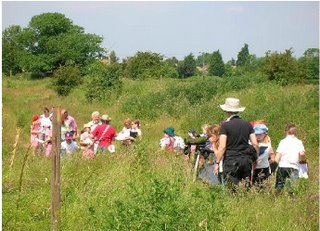
When I was a lil ole boy, we spent every spare moment romping through fields, wading across streams, falling out of trees and into ponds and generally putting our lives at risk. Amazingly, almost all of us survived, and, in the process, learned a lot about the natural world around us, from the miracle of birds’ nests and frogspawn to the best saplings for making bows and arrows (If you want to see the places of my boyhood, sorry, they are all buried now under a monstrous wen called Telford).
Now that I am a old lil ole boy, my nature rambles are much more sedate and circumspect, but I had a chance recently to relive the excitements of my childhood. Vicariously. Thanks to a teacher from a local primary school called Amy Bell, who organised for three parties of her 7-9 year old pupils to come to our local meadows to see conservation in action. Amy was supported by her fellow teacher, Sarah, by some parents (who brought the children to the site in their cars) and by some members of the local conservation society. Despite the heat and some sneezing, the children had a wonderful time: watching wildlife in the ponds, finding (but not picking) wildflowers, listening to explanations of “jack go to bed at noon” , pennycress, hawksbeard and why kissing gates are called kissing gates, and admiring and sketching whatever took their fancy – leaves, grasses, sheep, swans on Guppy’s Pond.
What’s this called? Why this? How does that work? Where? How many? How big? Does it bite? Is it poisonous? (This last question asked about my darling Emperor Moth larvae, bright as a planet and big now as dinosaurs). Such frabjous enthusiasm! Such curiosity! Such a desire to know, to understand! A small piece of the National Curriculum brought gloriously to life. Other primary schools in the area have now expressed interest in bringing their pupils to the Meadows.
Oh yes, and nobody died. Amy did a risk assessment beforehand as the law now requires, a few warnings were issued, teachers and parents were vigilant (but not bossy or intrusive), the children went moreorless where they wanted to and did moreorless what they wanted to. And nobody died. Amazing! Just like when I was a lil ole boy! Good on you, Amy and Sarah and the enlightened Head of your school who gave his blessing to this blessed outing.
Do you ever walk across your lawn first thing in the morning and wonder about the droppings that weren’t there the evening before? Probably hedgehog. Anyway, there are some broad distinctions to be made to start with: carnivores’ dropping tend to be elongated and dark and slithery when wet (eg fox), herbivores’ round and pale and fibrous (eg rabbit). Even bird droppings can tell a tale. While I appreciate that poo may not be a suitable topic for afternoon tea at the vicarage, I think “reading the signs” in nature is very rewarding. For example, can you distinguish between a fox’s earth and a badger sett by the shape of the entrance hole? Can you separate the pellets of little owl, barn owl and kestrel? Easy, once you know how. It’s fun, and I bet those boys and girls from Amy’s primary school would lap up this kind of knowledge in no time. Just like those Indian trackers in Westerns who could read a universe in a broken twig. Just like I could when I was a lil ole boy.
No comments:
Post a Comment